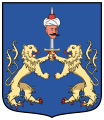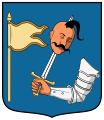Turk head (heraldry)

In European heraldry, the decapitated Turk head (Hungarian: Törökfej, Polish: Turecka głowa, Czech and Slovak: Turecká hlava, Serbo-Croatian: Turska glava, Турска глава, Ukrainian: Турецька голова, romanized: Turetska holova), most often as pierced by a sword, signifies the many wars fought by European Christian states against the invading Muslim, Turkish-led Ottoman Empire. Other depictions include the head held up by a victor or picked by a raven. It is used in modern town, municipality and village coat of arms in Hungary, Serbia and Croatia.
List
Cities and towns
- Hungary: Bezeréd, Derecske, Komádi, Gáborján, Hajdúdorog, Hajdúnánás, Szécsény, Tépe
- Serbia: Kikinda, Vršac
- Croatia: Đelekovec
Families
It was adopted by some Austro-Hungarian nobility, such as:
- The Balogh of Nemčice (in Slovakia), Mezőcsávás (in Romania), Csegö (?), Szász-Czegö (?)
- The Schwarzenberg of Český Krumlov (in Bohemia)[1]
- The Baky
- The Benkeö of Kezdi-Sarfalva
- The Branovacki
- The Csernovics
- The Csernoevicz
- The Csokits
- The Dunca of Sajo
- The Eperjessy of Gyulafehérvár (in Romania)
- The Gaines
- The Kajdachy
- The Karácson
- The Kovács
- The Kruchió
- The Latinovics
- The Nagy
- The Okolicsányi
- The Pótsa
Gallery
-
Schwarzenberg family arms, with a crow pecking at a Turk's head
-
Arms of the town of Orlík nad Vltavou, Czech Republic
-
Arms of the town of Derecske, Hungary
-
Arms of the town of Hajdúdorog, Hungary
-
Arms of the Balogh family from Mezőcsávás, Hungary
-
Arms of the town of Tépe, Hungary
-
Arms of the city of Kikinda, Serbia
See also
Wikimedia Commons has media related to Turk head (heraldry).
References
- ^ Charles Stickney (May 2001). World Enough: Travel Memoirs. iUniverse. p. 23. ISBN 978-0-595-18474-3.
Further reading
- Palmira Brummett (19 May 2015). Mapping the Ottomans. Cambridge University Press. pp. 209–. ISBN 978-1-107-09077-4.






